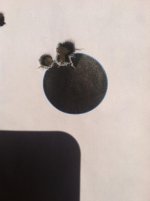A
Adam Daugherty
Guest
Folks, new to the forum. Getting a Hornady classic reloading kit for Christmas. They have a promotion to get 500 bullets with the purchase of this kit. I opted for 500 55 grain Hornady SP W/C bullets. What are some recommended recipes for this bullet for these two guns.
Howa 1500 Varminter in 223 with 1/12 twist barrel. This gun loves 40 grain v max factory loads. Which I plan to get some 40 grainers as well to reload, but that wasn't an option for the free bullets. I have tried 60 grain v max out of this gun and it is 1.25 inch groups at best at 200 yards. 40 grainers are consistent less than 1/2 inch groups at 200 yards. But was hoping I could get a load good enough out of the 55 grainers to be sufficient for coyotes.
Second gun is a Weatherby Vanguard bull barrel sporter in 22-250 with a 1:14 twist barrel. This gun is my father in laws and do not have much experience with it other than just some factory 55 grain Winchester ballistic tip varmint loads.
have bought dies and that is about it so I am open to which powder, primers, etc. for 223 will have some random brass from random factory loads and then some unshot hornady brass.
22-250 will be mostly spent Winchester brass.
Thanks for input
Howa 1500 Varminter in 223 with 1/12 twist barrel. This gun loves 40 grain v max factory loads. Which I plan to get some 40 grainers as well to reload, but that wasn't an option for the free bullets. I have tried 60 grain v max out of this gun and it is 1.25 inch groups at best at 200 yards. 40 grainers are consistent less than 1/2 inch groups at 200 yards. But was hoping I could get a load good enough out of the 55 grainers to be sufficient for coyotes.
Second gun is a Weatherby Vanguard bull barrel sporter in 22-250 with a 1:14 twist barrel. This gun is my father in laws and do not have much experience with it other than just some factory 55 grain Winchester ballistic tip varmint loads.
have bought dies and that is about it so I am open to which powder, primers, etc. for 223 will have some random brass from random factory loads and then some unshot hornady brass.
22-250 will be mostly spent Winchester brass.
Thanks for input


